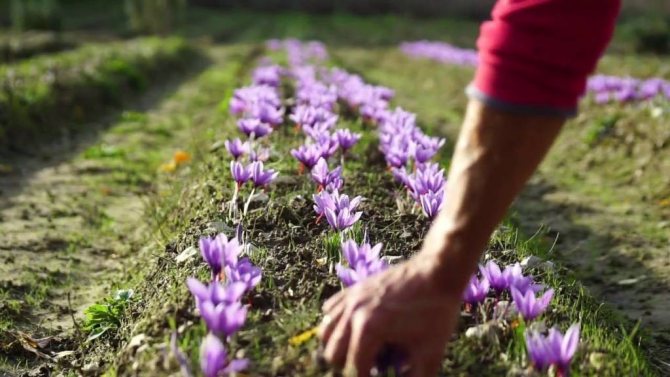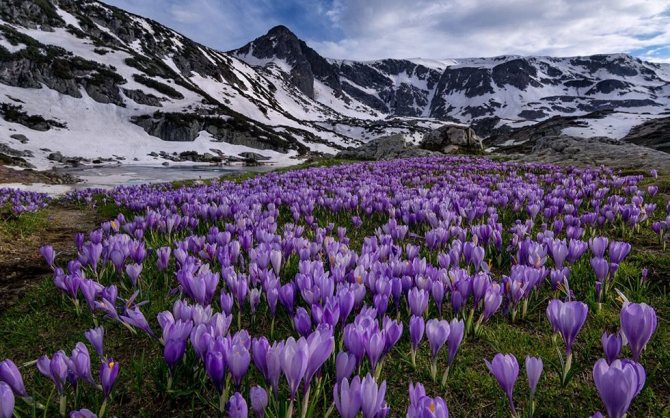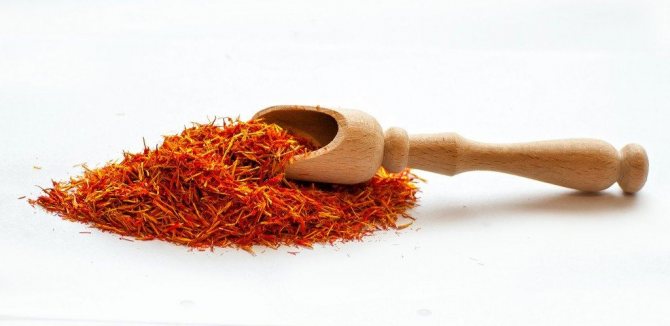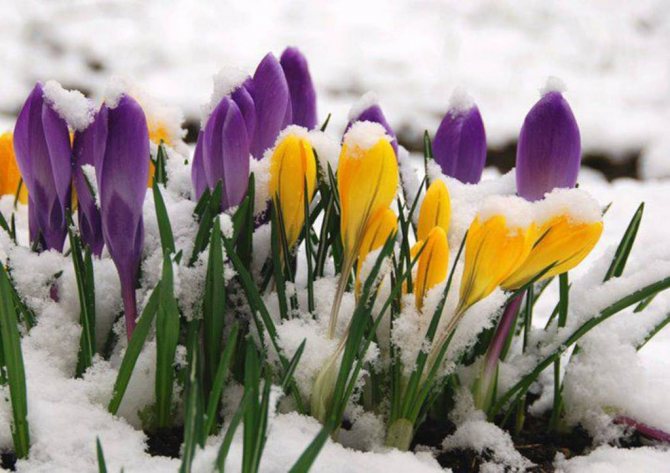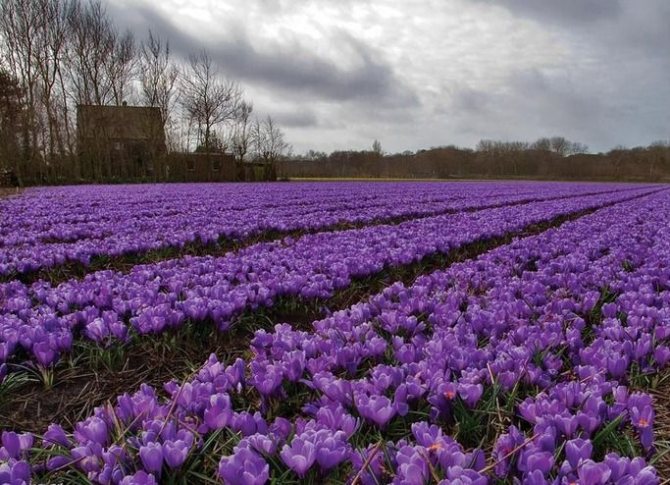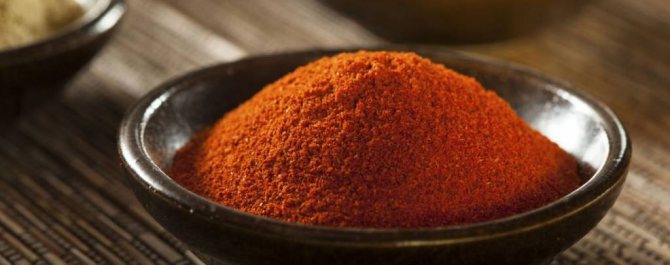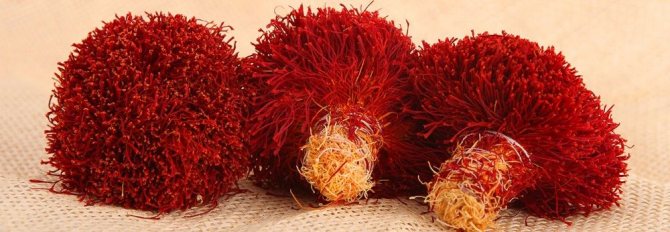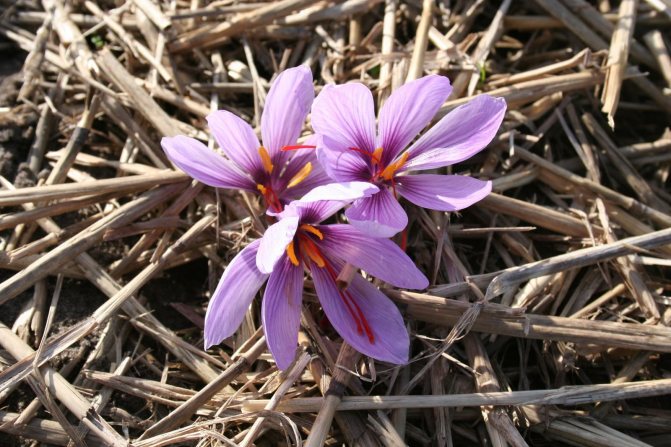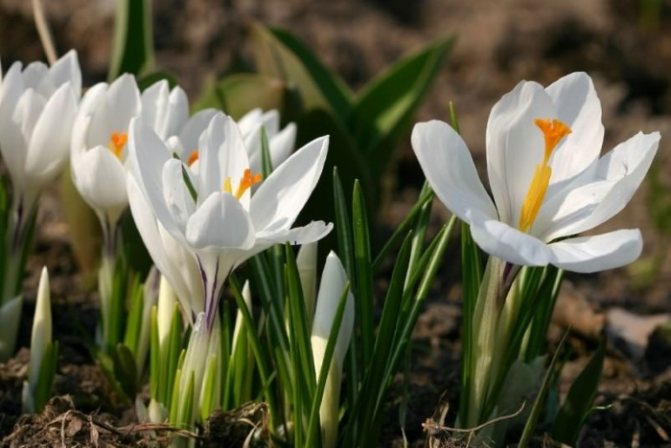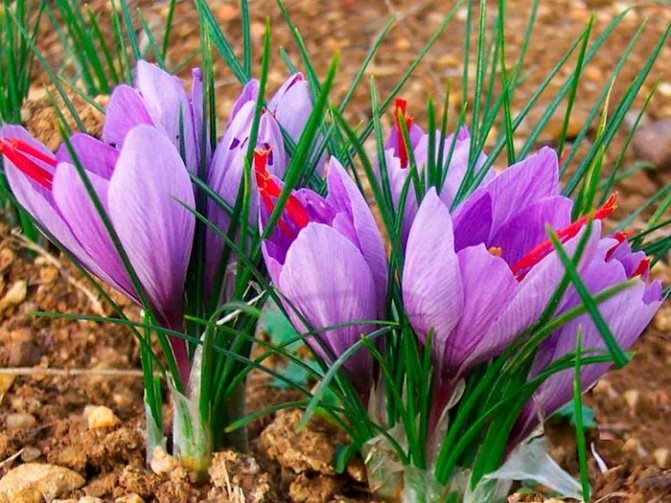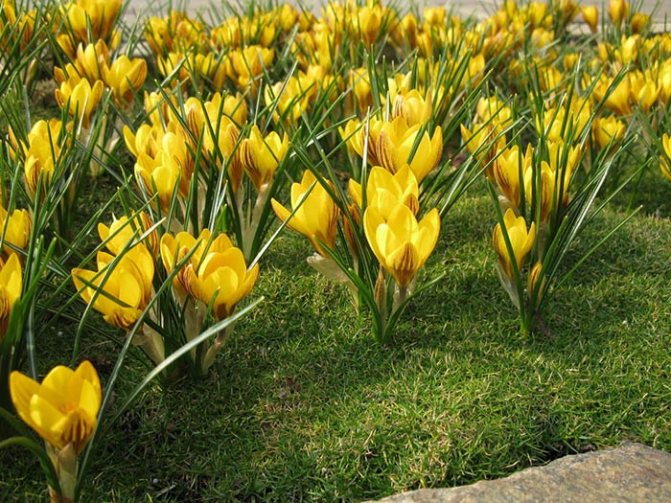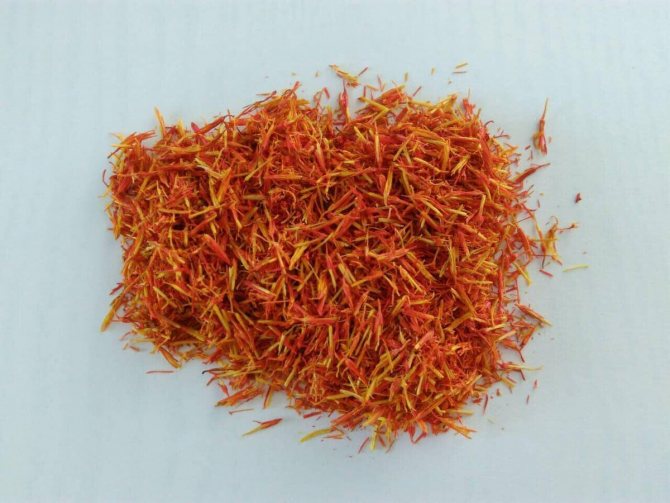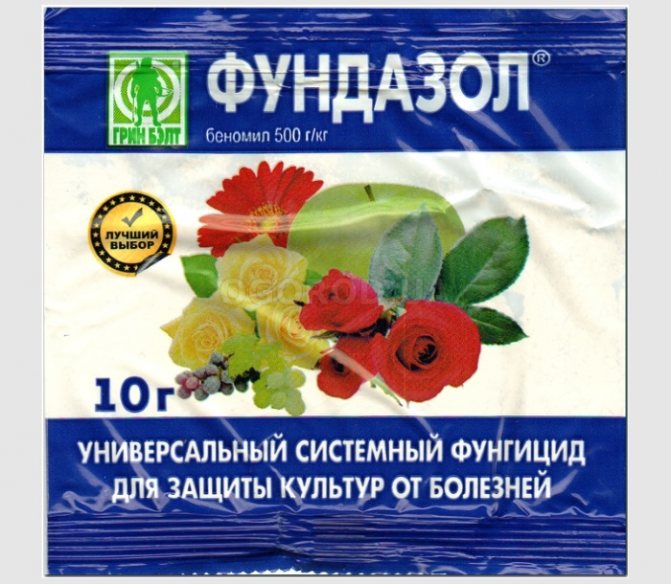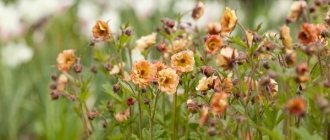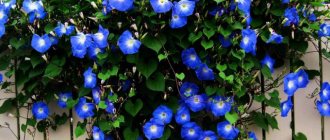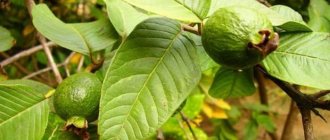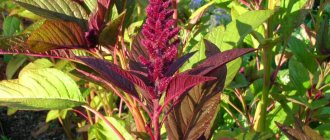Saffron is a plant known to the ancient Egyptians and the inhabitants of the mysterious East. In our world, not every gardener knows that saffron has another name - crocus. This plant is very popular for its beautiful early spring bloom, but in order to achieve it, saffron needs proper care. Further, in detail about how to properly grow saffron in the open field: features of planting, care, etc. (attached photo and instructions).
Taste and aroma of the spice saffron
Saffron is a vegetable spice and food coloring. According to the description, saffron looks like threads of a dark red color 3-5 cm long. They have an incredibly spicy aroma and a tart honey-bitter taste.
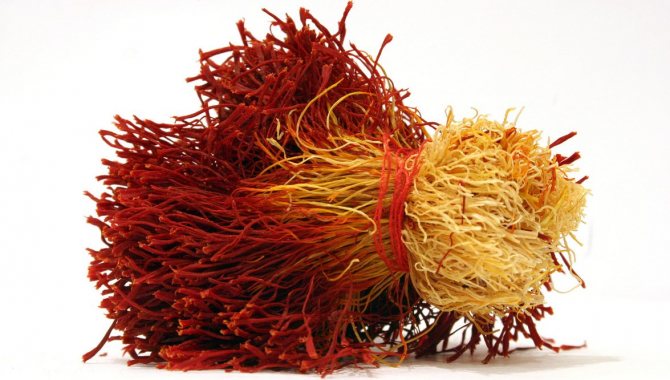
These stigma strings are single or sit in three on a yellowish base. Such photos can be found on the Internet. It should be noted that the light yellow lower part does not include dyes, and its length is no more than 1 cm.
Due to the aroma and spicy taste, the described spice is used in cooking when preparing meat dishes (pilaf, soup), fish, stewed vegetables, desserts and pastries, as well as in the manufacture of sausages, cheese. Even from a small thread of this spice, vegetable and meat dishes will acquire an incredibly spicy aroma and orange tint.
Important! You should adhere to the recommended dosage when consuming this spice - otherwise it may be poisoned. Three saffron flower stigmas are enough to flavor the dish.
Imeretian variety
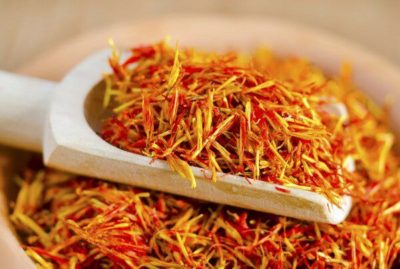

Another name is zafaran. Belongs to the Astrov family. An annual herb. According to the botanical description, Imeretian saffron is almost identical to marigolds:
- The stem is upright, up to 50 cm high.
- Leaves up to 11 cm long, finely dissected.
- Inflorescences appear in mid-summer.
You can also make a spice from Imeretian saffron. But it will differ from real saffron in taste, aroma and price (much cheaper).
Types of saffron
Depending on the growing area, there are different quality characteristics of saffron.
The following types are considered the most popular:
- Kashmiri... This spice is grown in the Kashmir and Himachal Pradesh regions (India). It has a rich dark ruby color and a pronounced aroma. There are three varieties of this spice: Shahi, Mogra, Lachha. Due to the small volume of production, it has the highest cost
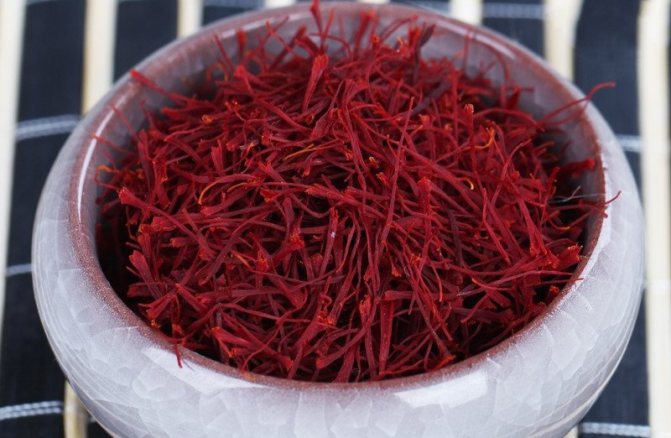

. - Spanish... Grown in Valencia and La Mancha (Spain). There are 2 grades: Coupe and Superior. The first of these has an incredible aroma and is the most appreciated, but the second is more widespread.
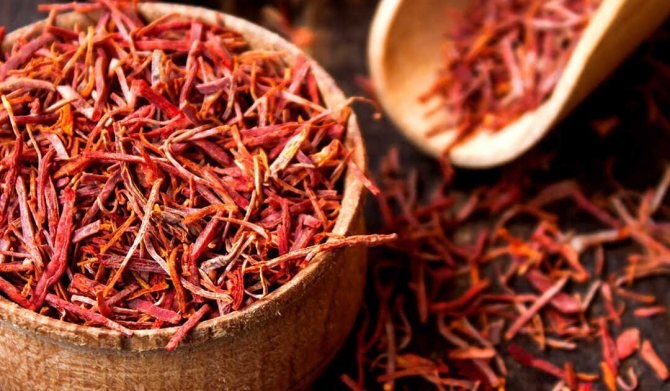

- Iranian... Grown on the territory of Razavi-Khorasan. It has good staining properties and has a more affordable price of $ 460.
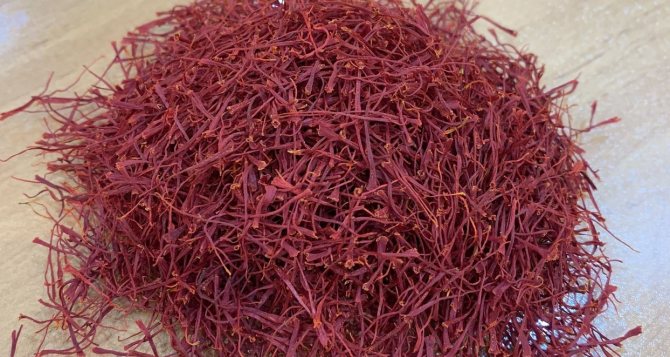

- Greek... Grows in Kozani. Complies with all environmental requirements and quality standards. Its price is about $ 800 per 1 kg.
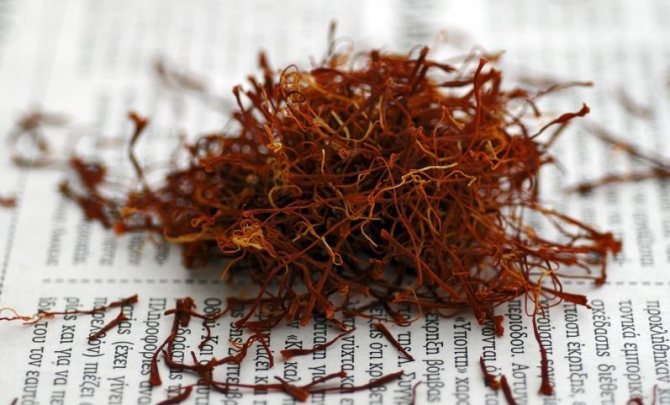

The described plant culture grows well in areas with a warm and dry climate. For this reason, it is also grown in eastern countries - Turkey, Tunisia, Azerbaijan, Pakistan, China, Japan, as well as in Mexico, New Zealand, etc. Now, it is grown on a small scale, even in Switzerland. T
Did you know? About 90% of saffron is grown in Iran and is mostly exported. There it is called "red gold".
Turkish and Tunisian saffron can be found on sale, but you should be careful - often in the markets safflower, better known as American saffron, is given out for the desired spice. It is used as a substitute, but it is inferior to the original in many respects.
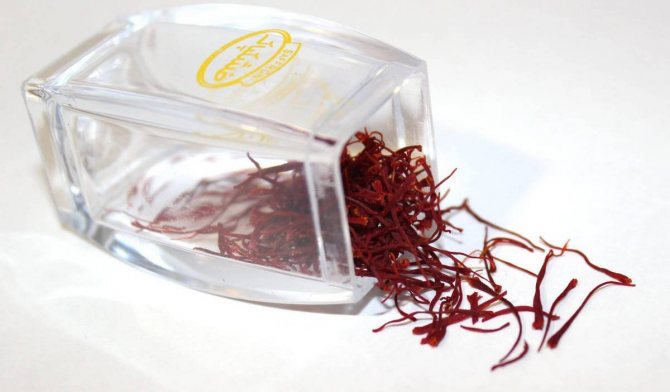

In 2014, the cost of 1 kg of this spice was about $ 2000: such a high cost was due to the complexity of preparation - 1 flower gives about 3 stigmas, and for 1 kg of saffron it is necessary to collect 100-200 thousand flowers by hand. This plant massively blooms for about two weeks, and the buds live no more than 3 days.
The so-called Imeretian saffron is made from another plant - marigolds, does not have a luxurious aroma of natural spices and is much cheaper. These substitutes also color foods well yellow or orange and are good to eat, but they are not so highly prized.
Important! When buying, you should definitely evaluate the appearance and strong saffron smell of this spice. In addition, it should be remembered that a real spice cannot be cheap, and it is better to buy it as a whole, and not in a ground form.
Description
This is a perennial herbaceous bulbous flower with narrow foliage growing directly from the bulb. From there, tubular flowers also crawl out. On the underside of saffron stems and foliage, scales are visible, they are transparent and thin. The flowers are unisexual, the perianth is six-partite in the form of a corolla of bright color.
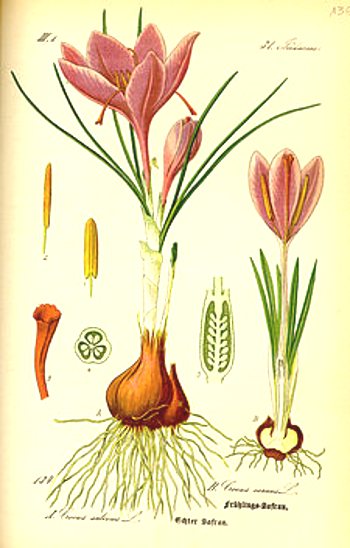

Crocus structure
The stigma and stamens (usually 3) are hidden inside the bud. The color of the stamens is bright, can be yellow, orange or red. The ovary, from which the fruit is subsequently formed, first grows under the ground, the ripening fruit is pushed outward, where it ripens. If the seeds are not harvested on time, then the ripe fruit opens and the seeds spill out onto the ground. Flowers are pollinated by flying insects - bees, wasps.
Crocus buds are very similar in shape to tulips, only smaller in size. Their colors can be yellow or blue. There are varieties with white buds.
The bulbs of these perennials are actively used for food, which are boiled, baked, or used in the preparation of other dishes. However, the most valuable thing in saffron is its stigma with stamens - they are used to prepare the “queen” of all spices. Also, yellow dyes and medicines are prepared from them. The spice made from stigmas and stamens is the most expensive, but it is also often counterfeited.
What spice is made of
The aromatic spice in question is made from the dried stigmas of saffron flowers (crocus sativus)... This type of plant culture is a perennial of the Iris family and belongs to the genus Saffron, whose representatives also have another name - crocuses.
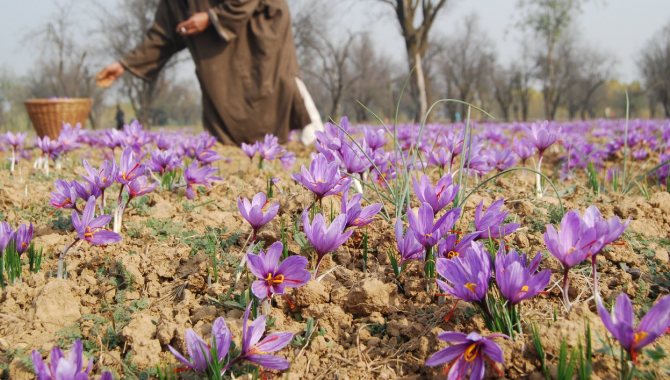

In natural nature, saffron does not occur, since it is a plant cultivated by man. In the photographs, this flower is very similar to the decorative crocuses grown by flower lovers in the gardens.
The flower reaches a height of about 120-300 mm. It has tubers in the form of a rounded bulb with small shoots measuring 2.3–2.5 cm in diameter. Straight narrow leaves of a fairly dense structure and only a few millimeters wide. There are about 10-15 of them in a bundle. They are colored dark green with a light stripe in the center.
The plant gives color in the form of large, faded purple, yellow or white buds that smell very strong. The perianth of a simple shape with fused petals has a long tube, at the limb it is painted in a darker color.
Read more about where it grows and what varieties of saffron are.
There are 3 stamens, and the ovary has filamentous pale yellow pistils, which are divided into 3 stigmas (stamens) about 3 cm long. They have an intense orange-red color.The fruits are boxes that look like a triangle.
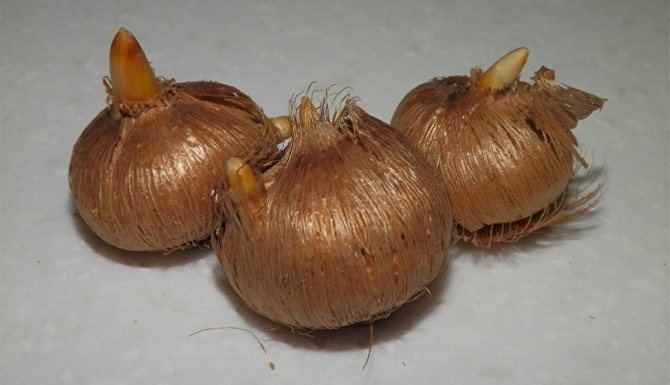

Plants reproduce only by corms, which are formed near the mother bulb.
Growing and harvesting saffron
A favorable climate greatly influences obtaining a good harvest. The described crop loves warmth and good lighting, as well as fertile soils with good drainage.... It does not tolerate excessively wet and swampy soil, rainy weather, but the amount of precipitation should be at least 1,000 mm per year.
Grows well in the south, where soils are dry. The best weather for saffron is the weather with heavy rains in spring and dry summer. It tolerates temperatures down to –18… –14 ° С in winter. It can be grown outdoors in the southern regions of the Crimea.
Did you know? Sowing saffron was presumably obtained on the Greek island of Crete in ancient times. The inhabitants of the Minoan civilization grew it as early as 2 thousand years BC.
It is also important to observe the crop rotation and grow this spice in the same area for no more than 5 years in a row. To obtain the desired harvest, it is also necessary to feed with nutrients. It will not be superfluous to add sand and rotted manure to the soil before planting. Mineral fertilizers are also suitable for this purpose, but they should be used within reasonable limits. Periodically, the soil should be loosened and weeds removed.
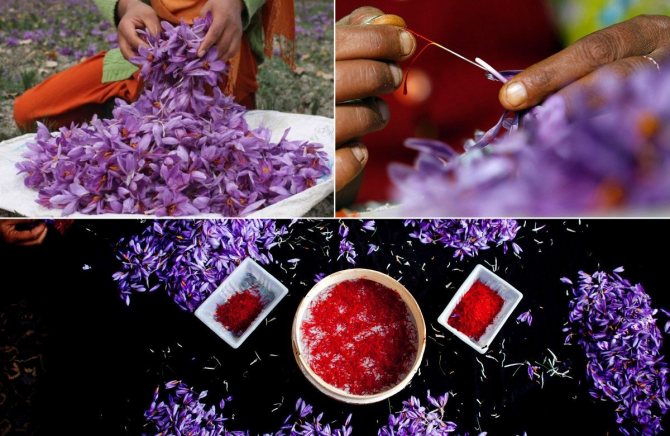

The saffron harvest is usually carried out in September - November, when the flowers bloom. Filamentous stigmas (stamens) are taken from the buds by hand. Then the harvested crop is dried in the shade or in special dryers. From 1 hectare, depending on the level of yield, 8–20 kg of spices are harvested.
For reproduction, a part is separated from the maternal corms or the onion babies that appear are planted. For collection in the fall, planting is carried out from spring to early July. This plant is not obtained by the seed method. Corms for planting should be purchased from reputable suppliers.
Find out what coriander seasoning looks like.
In the middle lane, planting in the fall is best done indoors due to rainy weather:
- For this, containers are used. A layer of gravel or river sand is poured onto their bottom as drainage, and then fertile soil is placed.
- The bulbs are planted at 7 cm intervals.
- Then the containers are placed in a cool room with a temperature regime not higher than + 9 ° C. It is important to ensure that daylight illumination is 4-5 hours a day.
- In April, containers are moved to a warmer place. Plantings are watered once every 2 days.
- After the saffron stops blooming, the foliage is cut off.
- Sometimes, after the first flowering, the second begins. Then the humidification is stopped, and the containers with the plantings are taken to a cool room.
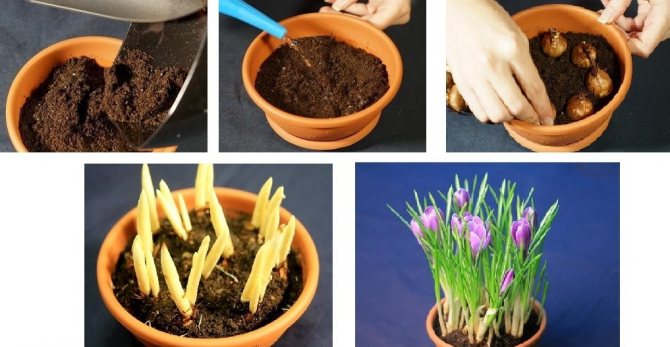

If heavy rains begin during flowering, the plant begins to ache, which significantly reduces the yield of the crop. Most often in this case, fungal diseases appear: first of all, it is rust. It can also be caused by an excess of nitrogen fertilizers on the site.
The disease can be detected by small rusty spots on the leaves, which gradually grow. Putrid formations appear on the flowers, over time the foliage dries and dies off. In this case, Bordeaux liquid or other copper-containing preparations helps well.
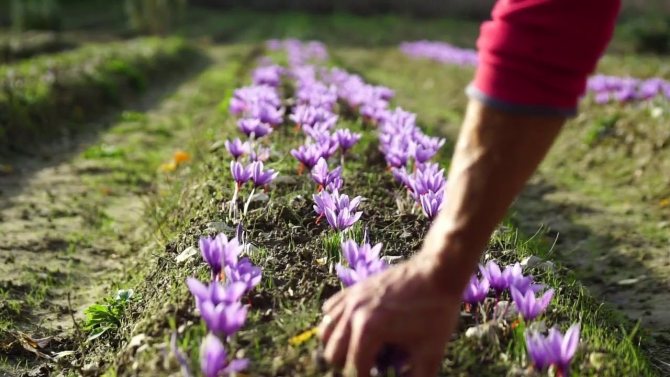

Saffron needs to be watered in moderation and at the root, and also not to thicken the planting... Be sure to feed the plants with phosphorus-potassium fertilizers. Rodent pests can spoil the crop, which damage the corm.
To combat them, various scarers and protective nets are used. You can also use insecticides, but only if the saffron is not going to be used for treatment.
Crocus - growing
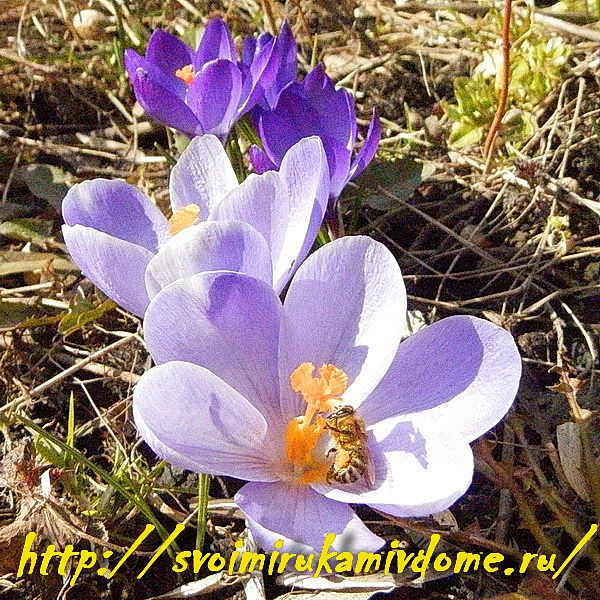

Crocuses and bee
It is easy to grow crocus in the ground, the main condition is that the bulbs (bulbous tubers, corms) must be planted in the fall so that they have time to take root. Planting depth 6-8 cm. Crocuses grow best on light soils and open places. But I have them growing on a fairly heavy rocky soil. It is very good to plant crocuses in flower beds, ridges and borders for bulbous plants.
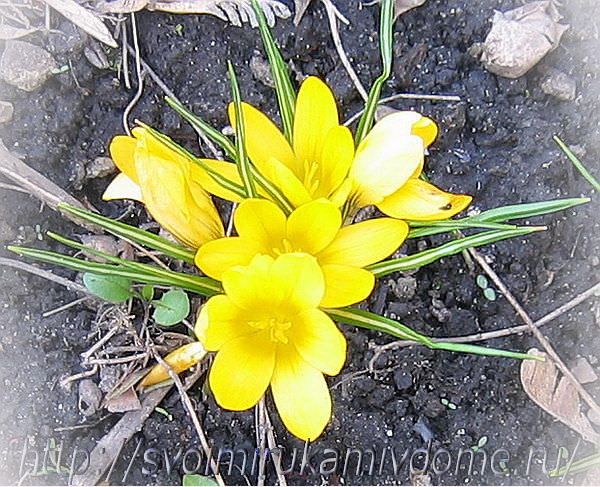

Crocus yellow
If you want to grow crocuses in a pot for winter flowering, you need to plant several corms in a pot at the end of August-September-October and dig in, covering them with a layer of earth up to 10 cm.After one and a half to two months, the tops of the leaves will appear, after which the pot must be placed in a light cool room (preferably in a greenhouse at a temperature of 6-8 degrees), watering as needed. Indeed, for good flowering crocuses need light and low temperature.
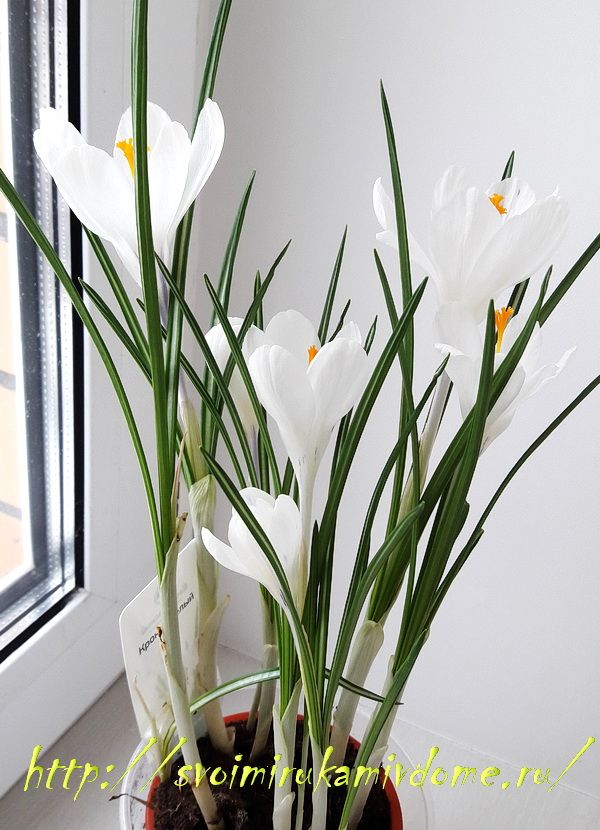

White crocuses bloomed
In an apartment, a crocus in a pot will bloom well on cool, light windowsills. Only drafts are best avoided. Corms of faded crocuses can be removed from the pot, stored in a cool dry place, and planted in a flower garden in the fall. I don’t dig my crocuses out of the ground for the summer, I think it is possible in the spring to carefully transplant faded plants with roots from the pot into a flower garden next to other primroses when the ground warms up.
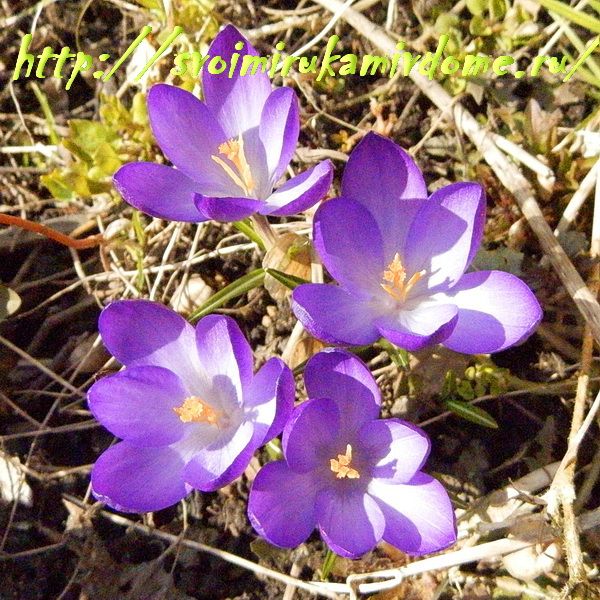

Lilac crocuses
Healing properties
Saffron is used not only in cooking but also for medicinal purposes.


- For the human body, this spice brings the following benefits:
- stimulates digestion and increases appetite;
- improves metabolic processes;
- has an antidepressant effect, helps fight insomnia;
- activates the brain;
- has a mild analgesic effect, relieves spasms;
- is an antioxidant that helps to preserve youth and is the prevention of cancer;
- enhances libido in men and women, is considered an aphrodisiac;
- helps with coughs and colds;
- strengthens the body:
- has a beneficial effect on the cardiovascular system.
Important! There are contraindications to the regular consumption of the described spice: pregnancy, lactation, age up to 2 years, hypertension and allergies to it.
What is the difference?
The main difference is belonging to different plant families.... The effect on the human body is also significantly different: saffron has anti-aging and healing properties in general, marigolds affect individual systems of the body.
However, other plants are often suggested as substitutes for saffron. Among them are Indian turmeric, Mexican safflower, widespread calendula ("poor man's saffron"), a mixture of spices "curry" and Imeretian saffron, which is loved in the Caucasus and especially in Georgia. It is most often confused with saffron.
How and how much saffron is stored
Saffron should be stored in a hermetically sealed container. How long and how long the seasoning will last depends on the environment. A place for it must be chosen dark and dry, where the temperature does not become more than + 20 ° С. In such conditions, its shelf life will be, like most spices, 2 years. It is possible to determine a non-expired, high-quality product by its strong smell, which seeps even through the container.
Saffron is an expensive and luxurious spice that gives dishes an exquisite aroma and taste, coloring them orange. It has medicinal properties. Due to the high cost, you can often find fakes of this spice on sale. It can be grown from corms by ourselves, but only under favorable conditions.
Subtleties of application
If you want the dish to turn evenly golden, I recommend soaking the saffron strings in warm water for 10-20 minutes. Add the saffron along with the liquid just before the end of cooking.
Ground saffron can be added to a dish just like that.
There is another way to use saffron. First you need to dry the saffron strands in a dry hot frying pan - this will enhance the aroma of the spice. Then they need to be ground into powder, mixed with a spoonful of warm water and added to an almost finished dish, warm milk or dough.

